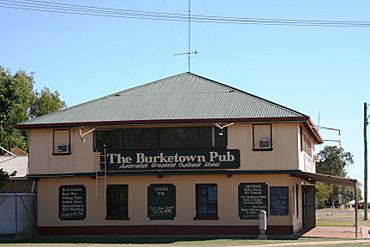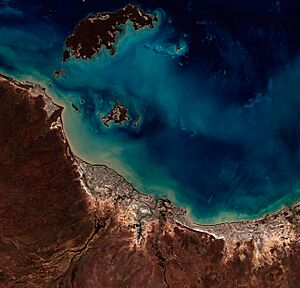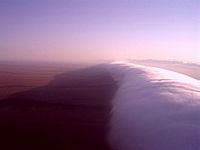Burketown facts for kids
Quick facts for kids BurketownQueensland |
|||||||||||||||
|---|---|---|---|---|---|---|---|---|---|---|---|---|---|---|---|

Burketown pub (since destroyed)
|
|||||||||||||||
| Population | 204 (2021 census) | ||||||||||||||
| • Density | 0.11907/km2 (0.3084/sq mi) | ||||||||||||||
| Established | 1865 | ||||||||||||||
| Postcode(s) | 4830 | ||||||||||||||
| Elevation | 6 m (20 ft) | ||||||||||||||
| Area | 1,713.3 km2 (661.5 sq mi) | ||||||||||||||
| Time zone | AEST (UTC+10:00) | ||||||||||||||
| Location |
|
||||||||||||||
| LGA(s) | Shire of Burke | ||||||||||||||
| State electorate(s) | Traeger | ||||||||||||||
| Federal Division(s) | Kennedy | ||||||||||||||
|
|||||||||||||||
|
|||||||||||||||
Burketown is a small, isolated town in the outback of Queensland, Australia. It is located on the coast in the Shire of Burke. In 2021, about 204 people lived in Burketown.
The town is about 898 kilometres or 558 miles west of Cairns. It is also 227 kilometres or 141 miles west of Normanton. Burketown sits on the Albert River and is part of the Savannah Way area. This region is known as the Gulf Savannah.
Contents
Where is Burketown?
Burketown is in the northwest of Queensland. It is about 2,115 kilometres (1,314 mi) from Brisbane, the state capital. The closest larger town is Normanton, 227 kilometres (141 mi) to the east. The nearest city is Mount Isa, 425 kilometres (264 mi) to the south.
The town is about 30 kilometres (19 mi) inland from the Gulf of Carpentaria. It is the main office for the Burke Shire Council.
Burketown's History
First Peoples of the Land
Aboriginal Australian peoples have lived in this area for thousands of years. The Yukulta / Gangalidda and Garawa peoples are the traditional owners of the Burketown land. Their native title rights were officially recognized in 2015.
In the 1930s, a mission station was set up in Burketown. It later moved to Bayley Point, becoming the Old Doomadgee Mission. Sadly, many Aboriginal children from this region were taken from their families. They were moved to missions further south.
Early European Exploration
In 1841, Captain J. Lort Stokes was the first European to find the mouth of a river here. He named it the "Albert River" after Prince Albert. Stokes explored the area and called the wide, grassy plains "The Plains of Promise."
How the Town Started
Burketown was named after explorer Robert O'Hara Burke. He was one of the first Europeans to cross Australia from south to north. The first European settlers arrived in the area after Burke's journey. By the mid-1860s, cattle stations like Gregory Downs were set up.
In 1865, Robert Towns officially started Burketown. He was a rich businessman from Sydney. He wanted Burketown to be a port and supply center for his cattle properties. Towns also helped start Townsville in the same year.
By September 1865, about 40 people lived there. A store and a hotel were being built. Money was scarce, so businesses made their own paper notes. In 1866, a police force arrived. The first horse race meeting was held in July 1866.
Sadly, the arrival of settlers led to conflict and violence with the Aboriginal people. Many lives were lost during this time.
Burketown Post Office opened in 1866. It closed for a while but reopened in 1883.
Challenges and Changes
In the late 1860s, a disease called "Gulf Fever" spread through the town. Many people died, and survivors moved to Sweers Island for safety.
A strong tropical cyclone hit Burketown in 1887. It caused huge floods, and only the highest parts of town were safe. Seven people died in the storm.
Burketown State School opened in 1888.
Many Chinese men also came to the Gulf Country in the late 1800s. They came after gold was found in other parts of Queensland and the Northern Territory. A law in 1891 made it very hard for Chinese people to enter Queensland. Many tried to walk overland from the Northern Territory to avoid the high taxes. Some were arrested near Burketown. However, many stayed and lived near the town. They often formed families with Aboriginal people. Today, many people in the area have Chinese heritage.
Chinese residents also created a successful market garden at Woods Lake. They grew fresh vegetables, which were important for health. This garden supplied Burketown and even sent produce to Thursday Island.
Some of Burketown's old hotels were destroyed by fire. The Burketown Hotel, built in 1920, burned down in 2012. It has since been rebuilt.
How Many People Live Here?
- In 2006, Burketown had 173 people.
- In 2011, the population was 201 people.
- In 2016, it grew to 238 people.
- In 2021, the population was 204 people.
Important Places
Burketown has several places listed for their historical importance:
- Landsborough Tree
- Former Burketown Post Office, Musgrave Street
- Boiling Down Works, Truganinni Road
- Old Westmoreland Homestead, 150 kilometres (93 mi) west-north-west of Burketown
Weather in Burketown
Burketown has a hot, dry climate for most of the year. It has hot, humid summers with rain and warm, very dry winters. December is the hottest month, with average high temperatures around 35.4 °C (95.7 °F).
Most of the rain falls from December to March. Heavy rain can cause floods, sometimes cutting off the town for months. Long dry periods can also happen.
| Climate data for Burketown (17º44'24"S, 139º33'00"E, 6 m AMSL) (1890-2009 normals and extremes, rainfall 1886-2024) | |||||||||||||
|---|---|---|---|---|---|---|---|---|---|---|---|---|---|
| Month | Jan | Feb | Mar | Apr | May | Jun | Jul | Aug | Sep | Oct | Nov | Dec | Year |
| Record high °C (°F) | 45.2 (113.4) |
43.2 (109.8) |
41.1 (106.0) |
40.6 (105.1) |
37.1 (98.8) |
35.0 (95.0) |
34.6 (94.3) |
36.0 (96.8) |
39.0 (102.2) |
41.7 (107.1) |
44.4 (111.9) |
43.8 (110.8) |
45.2 (113.4) |
| Mean daily maximum °C (°F) | 34.2 (93.6) |
33.6 (92.5) |
33.5 (92.3) |
33.1 (91.6) |
30.5 (86.9) |
28.0 (82.4) |
27.7 (81.9) |
29.4 (84.9) |
31.9 (89.4) |
34.2 (93.6) |
35.4 (95.7) |
35.4 (95.7) |
32.2 (90.0) |
| Mean daily minimum °C (°F) | 25.0 (77.0) |
24.7 (76.5) |
23.5 (74.3) |
20.8 (69.4) |
17.1 (62.8) |
14.3 (57.7) |
13.1 (55.6) |
14.5 (58.1) |
17.8 (64.0) |
21.1 (70.0) |
23.7 (74.7) |
24.8 (76.6) |
20.0 (68.1) |
| Record low °C (°F) | 17.2 (63.0) |
16.1 (61.0) |
15.0 (59.0) |
9.9 (49.8) |
5.7 (42.3) |
4.4 (39.9) |
3.3 (37.9) |
3.7 (38.7) |
7.6 (45.7) |
10.9 (51.6) |
14.2 (57.6) |
15.0 (59.0) |
3.3 (37.9) |
| Average precipitation mm (inches) | 224.4 (8.83) |
202.4 (7.97) |
159.8 (6.29) |
25.9 (1.02) |
6.2 (0.24) |
5.7 (0.22) |
2.5 (0.10) |
1.0 (0.04) |
1.8 (0.07) |
12.7 (0.50) |
40.1 (1.58) |
115.8 (4.56) |
808.6 (31.83) |
| Average precipitation days (≥ 1.0 mm) | 10.3 | 10.3 | 6.7 | 1.5 | 0.6 | 0.5 | 0.3 | 0.1 | 0.3 | 1.0 | 3.0 | 6.1 | 40.7 |
| Average afternoon relative humidity (%) | 57 | 59 | 51 | 40 | 36 | 35 | 33 | 31 | 34 | 38 | 43 | 50 | 42 |
| Average dew point °C (°F) | 22.0 (71.6) |
22.2 (72.0) |
20.0 (68.0) |
15.4 (59.7) |
12.0 (53.6) |
9.3 (48.7) |
7.6 (45.7) |
8.0 (46.4) |
11.0 (51.8) |
14.9 (58.8) |
17.8 (64.0) |
20.5 (68.9) |
15.1 (59.1) |
| Source: Bureau of Meteorology (1890-2009 normals and extremes, rainfall 1886-2024) | |||||||||||||
Morning Glory Clouds
From August to November, a special cloud formation called the "Morning Glory" can be seen. These are long, tube-shaped clouds, sometimes 1,000 kilometres (620 mi) long!
These clouds are a big attraction for glider pilots. They can "surf" the air waves created by these clouds. Gliding flights of over 500 kilometres (310 mi) are common here.
Schools and Learning
Burketown State School is a primary school for students from Prep to Year 6. In 2018, it had 27 students.
There are no high schools in Burketown. Older students can go to schools in Normanton (227 kilometres (141 mi) away) or Mount Isa (425 kilometres (264 mi) away). They can also learn through the Mt Isa School of Distance Education.
Town Services
Burketown has a post office, a council office, and a service station. There are also small shops, a bakery, and a caravan park. The town has a small hospital and a hotel.
The Royal Flying Doctor Service helps people in Burketown from their base in Mount Isa. The Burketown Airport has regular flights. It is also home to Savannah Aviation, which offers charter flights.
Other important services include:
- Burketown Police Station on Gregory Street.
- Burketown SES Facility on Musgrave Street.
- Burketown Primary Health Care Clinic (hospital) on Truganini Road.
- Burketown Ambulance Station at the health centre.
- Burketown Cemetery north of the hospital.
- A sewage treatment plant and a water treatment plant, run by the Burke Shire Council.
Things to Do
The Burke Shire Council has a public library on Musgrave Street.
There is a boat ramp and jetty on Truganina Road. It is on the north bank of the Albert River. This is managed by the Burke Shire Council.
Fun Attractions
Burketown is known as the "Barramundi capital of Australia." It holds an annual Barramundi Fishing Competition during Easter.
Escott Station is a tourist lodge about 17 kilometres (11 mi) from Burketown.
Burketown in Stories
Burketown is thought to be the inspiration for "Willstown" in the book A Town Like Alice by Nevil Shute. In the story, the town starts small but grows into a successful community.




